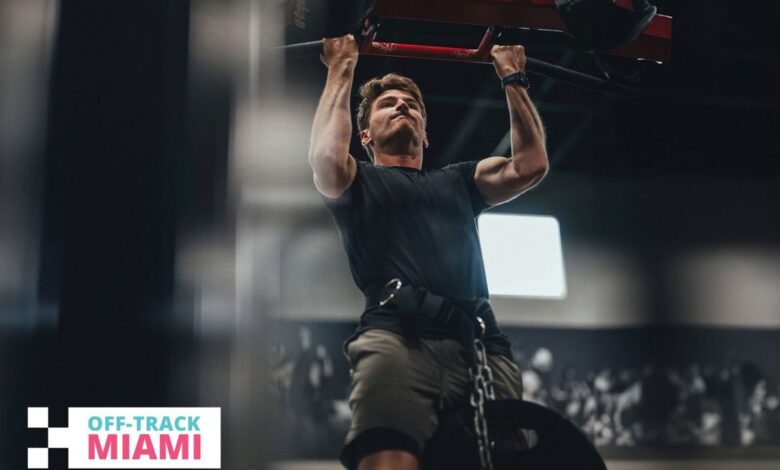Meet the trainer rebuilding Logan Sargeant after that 2023 Qatar DNF

It was the low point of Logan Sargeant’s rookie season in Formula 1: a DNF at the Qatar Grand Prix in October after the American driver nearly passed out from heat exhaustion. In his defense, the race was run under brutal conditions: 90-degree-Fahrenheit (32-degree Celsius) temps and high humidity led to unbearable cockpit heat. Sargeant wasn’t the only one who suffered—Alpine’s Esteban Ocon later claimed he had vomited in his helmet. The Williams newcomer had no way of knowing how his body would react to those extremes, but the DNF stung regardless.
“Before you drive in Formula 1, you don’t really know the areas you need to focus on,” says Sargeant. “After you go through that first season, you can really identify what to target. And on the back end of last year, I was far too light, a bit unhealthy—I think that unfortunately comes with the travel, fatigue, and length of the season.”

Logan Sargeant being helped through the paddock during the 2023 Qatar Grand Prix
Photo by: Williams F1
Heading into his sophomore campaign, Williams and Sargeant knew they had to prioritize fitness. Enter Elias Huhtinen, an affable, hulking Finnish fitness trainer with more than a decade of experience building the bodies (and minds) of Finnish soccer stars, future NHL players, and MMA fighters. Though Sargeant was his first F1 client—and a surprise one at that. Huhtinen applied for an anonymous motorsports job listing last year, only to discover he’d be working with the Williams driver. Working in Formula 1 had been a dream of Huhtinen’s. “How I ended up here, there’s a lot of luck involved, a lot of opportunities that have somehow folded the right way,” he says.
“I’ve coached more than 13 sports—a combination of strength and conditioning and mental coaching,” Huhtinen says from his home in Jyväskylä, Finland, where he’s preparing to jet off to Miami to reconnect with Sargeant ahead of this weekend’s race. “Funny enough, every time I go into a new sport, I face this thinking [from the athlete]: ‘Well, if you haven’t done our sport, how do you know what we need?’ But for every athlete, in the center of everything is being a human.”
Huhtinen takes a holistic approach, focusing as much on routine, health, and wellness as on the nuances of each workout. In particular, he trains athletes not just for always-on performance, but for handling the extremes of their jobs.

Logan Sargeant (right) running with trainer Elias Huhtinen.
Photo by: Williams Racing
“Surviving the traveling, the exhaustion, the tight schedules, the stress, the overall load of living,” he says.
Starting in January and continuing through the season, Huhtinen has arranged Sargeant’s schedule so that he works out anywhere from five to eight times a week. He calls the American a “well-rounded athlete,” with no real weaknesses or imbalances.
A typical workout session looks something like this: a 10-minute aerobic warmup, possibly on a bicycle or rower; exercises to activate the glutes; five rounds on the treadmill consisting of three-minute heavy intervals; isometric neck pulls; and then a battery of core movements and strength workouts for the shoulders and upper body.

Photo by: Williams Racing
The specifics and intensity of each workout vary depending on Sargeant’s schedule, and Huhtinen tries to work in double sessions as much as possible, given a driver’s hectic weekly schedule. Lighter days might focus more on lengthy aerobic exercises for building that Qatar-style endurance, while triple-header race weekends may only feature one true workout per week.
“You don’t want to take too much of a risk pushing the athlete between the races because over-stressing lowers your immunity, and you’re at risk of getting sick, for example,” he says.
Huhtinen emphasizes that pro athletes typically do the same types of workouts you might do at home or at the gym. “It’s disappointing for many people because they think athletes must always do something special or outside the box,” he laughs. “But from what I’ve seen, the best athletes do the basic stuff—they just do it better.”
Except for the neck pulls. Those are special—and specific. “No other athletes face those types of G forces like a Formula 1 driver,” he notes.
At the center of it all, though, is endurance, an aspect that both Sargeant and Williams were specifically looking to improve upon heading into season two. That’s not just about physically surviving a two-hour circuit in tropical temps, but mentally maintaining the right mindset to still compete.
“The races are quite long, and the heart rate gets pretty high, so the fitter he is, the better he’ll cognitively manage the race,” Huhtinen explains. To replicate the heat of the cockpit—and to ensure that Sargeant is ready for more potential Qatar-like conditions—Huhtinen tries to make workouts as uncomfortable as possible for the young American, often incorporating trips to the sauna before and after sessions.
“On the mental side, it helps to acclimatize to the heat,” he says.

Photo by: Williams Racing
Sargeant says he has enjoyed working with Huhtinen so far and has already noticed a physical difference.
“We’ve taken a huge step as far as cardio,” Sargeant says. “And we’ve clicked as far as relationship because we both have a similar mindset. We have a goal and we want to reach that goal. And just putting in the max amount of effort—it’s nice to have that mindset similar to someone else, who understands where you’re trying to go.”


